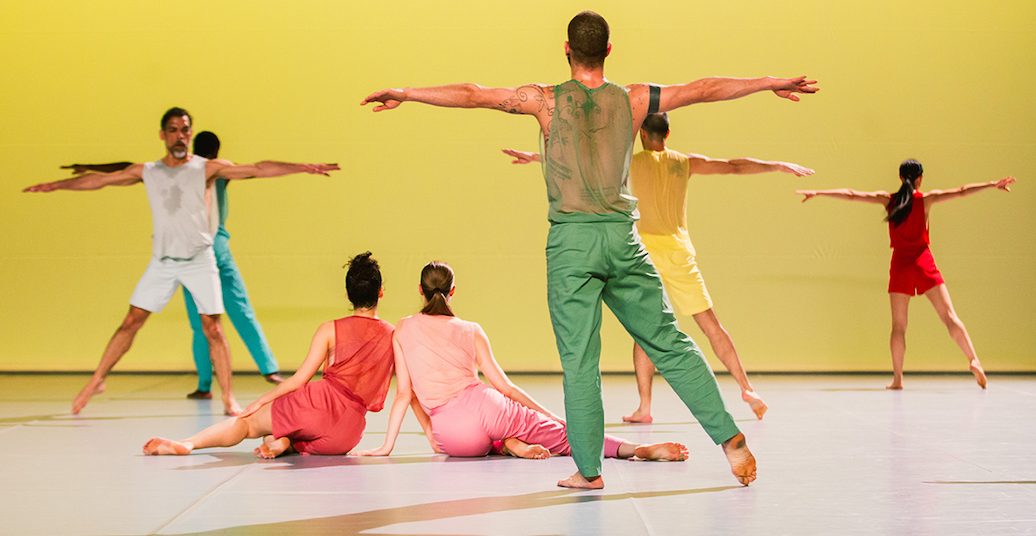After a digital premiere in March 2021 and a series of live performances with pre-recorded music 24-26 September, Sasha Waltz & Guests’ new work “In C” finally premiered to a live audience with live music performed by New York based ensemble “Bang on a Can All-Stars” at radialsystem from 10 to 12 December. “In C” is set to an eponymous piece by US American minimalist composer Terry Riley, and follows a variable structure of 53 movement patterns that 12 dancers combine and intertwine in a seemingly improvisational fashion.
Terry Riley’s landmark piece “In C”, written in 1964, has often been cited as one of the first compositions in the minimal music genre. It consists of 53 short musical phrases that have to be played in sequence, while allowing the performers the freedom to determine how many times each phrase is repeated. The length of each performance remains, therefore, adjustable and variable, and each time the piece is played, a new version of it is born. Sasha Waltz mirrored Riley’s approach and composed a series of 53 dance patterns along with a set of dramaturgical rules that determine the performers’ positions on stage and the general pace of the piece. These movement sequences are danced in a fixed order, but the performers are free to decide how many times each is danced, and also have the option to miss one out entirely. As a result, and similarly to Riley’s composition, Waltz’s “In C” is a dynamic and modular system that can be adjusted to a variable number of dancers and lends itself to the creation of inevitable countless iterations.
The show opens with 12 dancers silhouetted against a bright red backdrop. Rattling vibraphone sounds accompany them as they methodically unfold the first dance patterns: shoulder rolls, statuesque postures, shrugs and twists, angular elbow kicks, and sudden dashes across the stage. As the performers joyfully surf the music, the backdrop slowly explores the colour spectrum, lighting the stage in pastel blue, teal, bright yellow, or pink. One of the movement phrases has the dancers freeze, arms outstretched, as if bathing in this radiant glow. The dance is also loaded with ample gestures — hops, jumps, and twirls, skimming across the stage — which loop and overlap, uphold, and then disrupt the rushed pace of Riley’s music. Group scenes conspire to being both unexpected and, at the same time, surprisingly harmonious, and eventually make me wonder where the limits of the dancers’ liberty in playing with the dance score lie.
Toward the second part of this hour-long show, my focus wanes, and I start asking myself whether “In C” has already said all that it is going to. Stunning final scenes, however, prove the contrary. The musicians’ unabated virtuosity swiftly explodes the otherwise hermetic display of controlled refinement. The pace quickens, dancers exchange smiles, the backdrop shifts to turquoise and rose red, and Waltz’s somewhat reserved choreographysuddenly gains in significance and emotional force. Fuelled, no doubt, by the beaming beauty of the show’s finale, my memory plays an unexpected trick on me, and flashes back to the very first dance piece I ever saw.
In 2009, I attended Lucinda Childs’s “Dance” at Théâtre de la Ville in Paris. It was a formative experience in many senses. I was mesmerised by the sight of the ethereal dancers fluttering behind the translucent scrim to the sounds of Philip Glass’s piano score. Since then I have seen dozens of dance works set to minimalist music — by John Adams, Gavin Bryars, Steve Reich, and many others. So many, in fact, that I even came to believe that a ‘group choreography set to minimalist music’ had become a genre of its own. The pulsating repetitive patterns lend enchantment and a sense of unfeigned emotion to even the simplest movement, and its non-narrative quality fits well with postmodern dance and its rejection of literal representation. It would seem, however, that hardly any of the choreographers who work with minimalist scores set themselves ambitions other than creating a structurally complex, yet emotionally loaded tapestry of movements. Political agendas and radical statements are left to sprout elsewhere. Dance is allowed, of course, to be just beautiful, refined, and enchanting, however old-fashioned this statement might appear today. This is perhaps why, more than half a century after the premiere of “Dance”, choreographers are still flicking through catalogues of minimalist music in quest of inspiration. Sasha Waltz makes no exception, and it is for this reason that I feel that “In C” does not add anything revolutionary or new to the genre, even when it is compared with what Lucinda Childs did more than 40 years ago. Airy and hypnotising, albeit structurally complex, “In C” exudes flair and elegance. Its effect on me was, however, short-lasting, and the show’s magic quickly dissipated after the curtain call. It is perhaps because “In C” was initially designed as a formalistic exercise that it rarely reaches emotional highs. Nevertheless, it still rewards the spectator with instances of pure dance bliss.
“In C” by Sasha Waltz & Guests was shown at radialsystem on 10-12 December 2021. A live-stream was recorded on 12 December and will be available until 11 January 2022 on the company’s YouTube channel SashaWaltzGuests.
“In C”: Concept and Choreography — Sasha Waltz. Costume Design — Jasmin Lepore. Lighting Design — Olaf Danilsen. Concept and Dramaturgy — Jochen Sandig. Dance and Choreography — Sebastian Abarbanell, Edivaldo Ernesto, Melissa Figueiredo, Tian Gao, Hwanhee Hwang, Annapaola Leso, Michal Mualem, Sean Nederlof, Zaratiana Randrianantenaina, Aladino Rivera Blanca, Orlando Rodriguez, Joel Suárez Gómez. Live Music — Bang on a Can All-Stars: Bass — Robert Black. Piano — Vicky Chow. Percussion — David Cossin. Cello — Arlen Hlusko. Electric guitar — Mark Stewart. Clarinet and Saxophone — Ken Thomson. Sound Design — Andrew Cotton.




